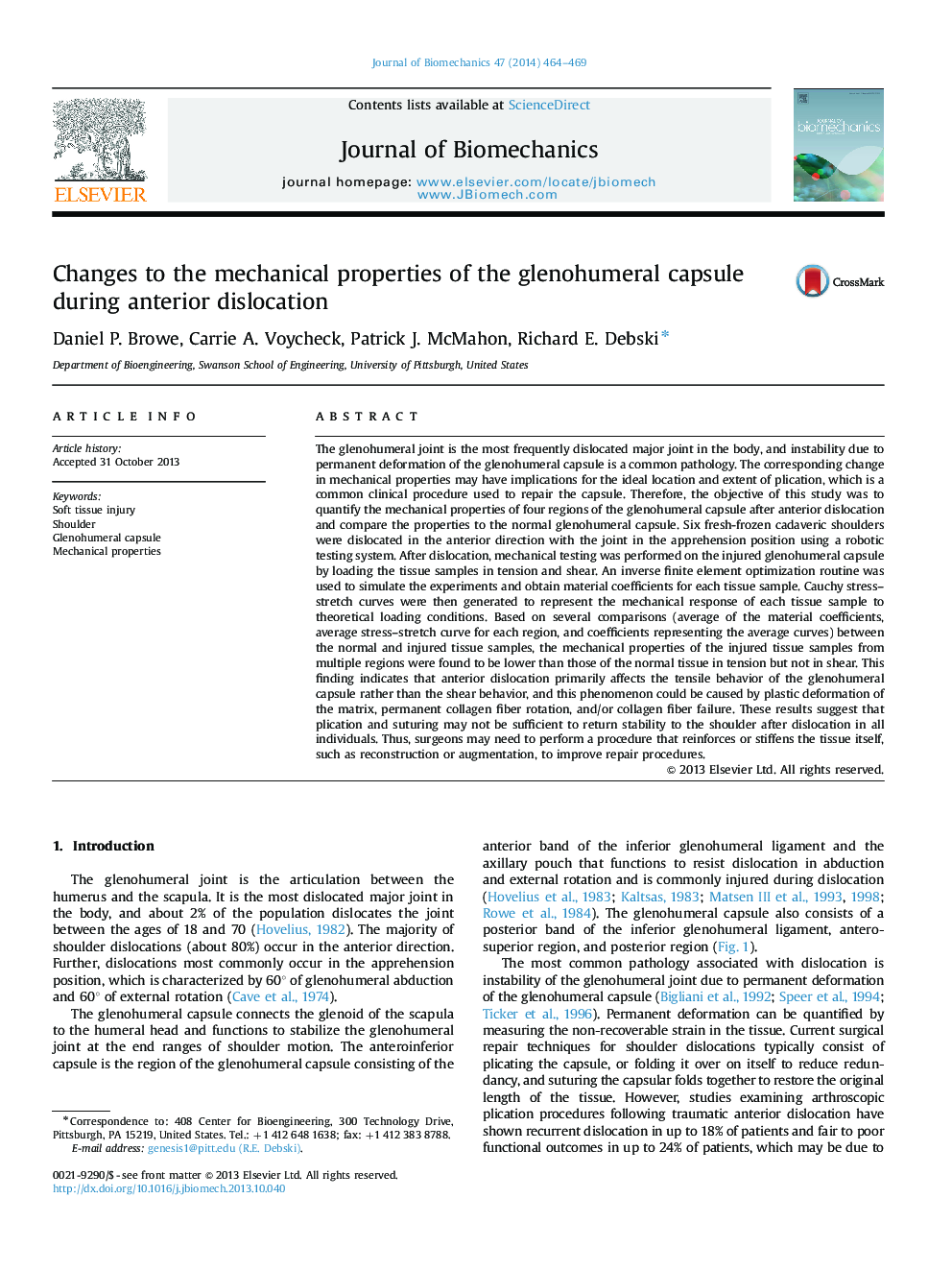| کد مقاله | کد نشریه | سال انتشار | مقاله انگلیسی | نسخه تمام متن |
|---|---|---|---|---|
| 10431557 | 910218 | 2014 | 6 صفحه PDF | دانلود رایگان |
عنوان انگلیسی مقاله ISI
Changes to the mechanical properties of the glenohumeral capsule during anterior dislocation
ترجمه فارسی عنوان
تغییرات در خواص مکانیکی کپسول گلنوموره در هنگام جابجایی قدام
دانلود مقاله + سفارش ترجمه
دانلود مقاله ISI انگلیسی
رایگان برای ایرانیان
ترجمه چکیده
مفصل گلنوهومرزه اغلب مفصل اصلی در بدن است و بی ثباتی ناشی از تغییر شکل دائمی کپسول گلنوموره یک آسیب شناسی رایج است. تغییرات متناظر در خواص مکانیکی ممکن است برای موقعیت ایده آل و گستردگی اشعه، که یک روش بالینی رایج برای تعمیر کپسول است، داشته باشد. بنابراین هدف این مطالعه، تعیین خواص مکانیکی چهار ناحیه کپسول گلنوهومرال پس از انقباض قدامی و مقایسه خواص با کپسول گلنوهومرال طبیعی بود. شش شانه ی مرطوب یخ زده در جهت قدام با مفصل در موقعیت بدبین با استفاده از یک سیستم تست روباتیک جابجا شد. پس از جابجایی، آزمایشات مکانیکی بر روی کپسول گلنوهومرال آسیب دیده با بارگذاری نمونه های بافت در تنش و برش انجام شد. برای شبیه سازی آزمایشات و به دست آوردن ضریب مواد برای هر نمونه بافت، یک روش بهینه سازی عنصر محدود عددی معکوس استفاده شد. سپس منحنی های کشش کششی کوشی برای نشان دادن پاسخ مکانیکی هر نمونه بافت به شرایط بارگیری نظری ایجاد شد. بر اساس مقایسه های چندگانه (میانگین ضرایب مواد، میانگین منحنی کشش استرس برای هر منطقه و ضرایب منحنی متوسط) بین نمونه های بافت عادی و آسیب دیده، خواص مکانیکی نمونه های بافت آسیب دیده از مناطق چندگانه پایین تر از بافت طبیعی در تنش، اما نه در برش. این یافته نشان می دهد که جابجایی قدام عمدتا تحت تاثیر رفتار کششی کپسول گلنوموره به جای رفتار برشی قرار دارد و این پدیده می تواند ناشی از تغییر شکل پلاستیک ماتریکس، چرخش فیبر کلاژن دائمی و / یا شکست فیبر کلاژن باشد. این نتایج نشان می دهد که پلاکت ها و بخیه ها ممکن است برای بازگشت ثبات به شانه پس از جابجایی در همه افراد کافی نباشد. بنابراین، جراحان ممکن است نیاز به انجام یک روش است که خود بافت را تقویت و یا تقویت می کند، مانند بازسازی یا تقویت، برای بهبود روش های تعمیر.
موضوعات مرتبط
مهندسی و علوم پایه
سایر رشته های مهندسی
مهندسی پزشکی
چکیده انگلیسی
The glenohumeral joint is the most frequently dislocated major joint in the body, and instability due to permanent deformation of the glenohumeral capsule is a common pathology. The corresponding change in mechanical properties may have implications for the ideal location and extent of plication, which is a common clinical procedure used to repair the capsule. Therefore, the objective of this study was to quantify the mechanical properties of four regions of the glenohumeral capsule after anterior dislocation and compare the properties to the normal glenohumeral capsule. Six fresh-frozen cadaveric shoulders were dislocated in the anterior direction with the joint in the apprehension position using a robotic testing system. After dislocation, mechanical testing was performed on the injured glenohumeral capsule by loading the tissue samples in tension and shear. An inverse finite element optimization routine was used to simulate the experiments and obtain material coefficients for each tissue sample. Cauchy stress-stretch curves were then generated to represent the mechanical response of each tissue sample to theoretical loading conditions. Based on several comparisons (average of the material coefficients, average stress-stretch curve for each region, and coefficients representing the average curves) between the normal and injured tissue samples, the mechanical properties of the injured tissue samples from multiple regions were found to be lower than those of the normal tissue in tension but not in shear. This finding indicates that anterior dislocation primarily affects the tensile behavior of the glenohumeral capsule rather than the shear behavior, and this phenomenon could be caused by plastic deformation of the matrix, permanent collagen fiber rotation, and/or collagen fiber failure. These results suggest that plication and suturing may not be sufficient to return stability to the shoulder after dislocation in all individuals. Thus, surgeons may need to perform a procedure that reinforces or stiffens the tissue itself, such as reconstruction or augmentation, to improve repair procedures.
ناشر
Database: Elsevier - ScienceDirect (ساینس دایرکت)
Journal: Journal of Biomechanics - Volume 47, Issue 2, 22 January 2014, Pages 464-469
Journal: Journal of Biomechanics - Volume 47, Issue 2, 22 January 2014, Pages 464-469
نویسندگان
Daniel P. Browe, Carrie A. Voycheck, Patrick J. McMahon, Richard E. Debski,
